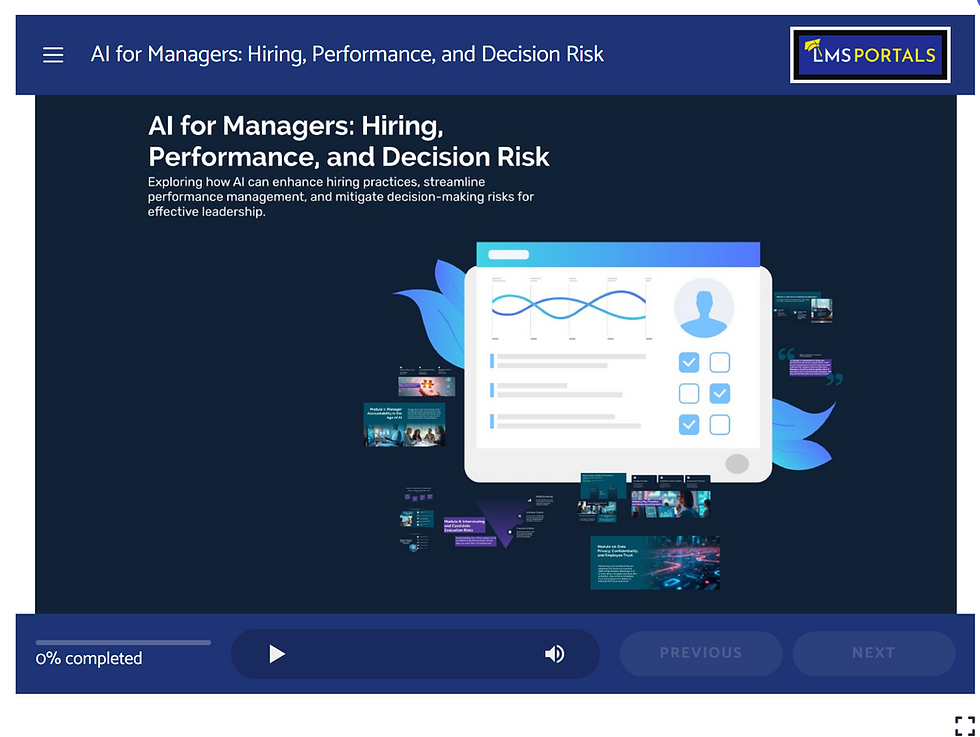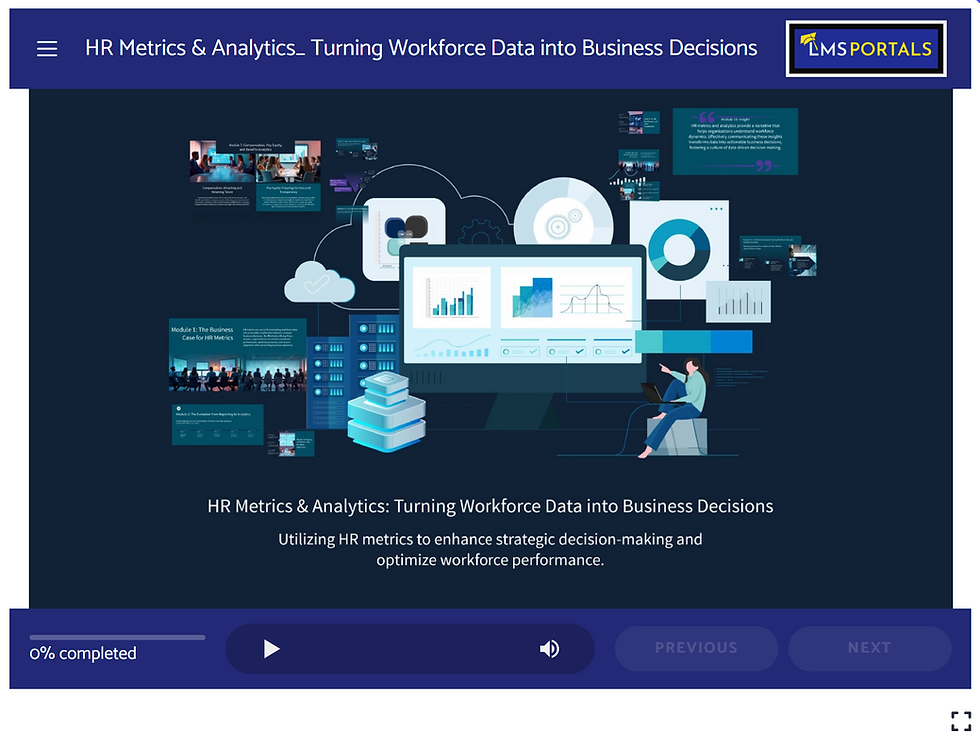The HR Consultant’s Edge: Turning Expertise into Recurring Revenue with eLearning
- LMSPortals

- Jun 13, 2025
- 6 min read

Introduction: The Shift from Services to Scalable Solutions
For years, HR consultants have worked on a cycle of billable hours, workshops, and project-based retainers. It's honest work—but it doesn’t scale. Every hour of income demands an hour of time. Growth usually means more clients, more hours, or building a full agency. Burnout follows closely behind.
But the market is changing. Companies now want scalable, flexible, and repeatable learning tools. They’re cutting back on live training and pushing for digital, on-demand formats that fit into the flow of work. The demand for impactful eLearning is exploding—and HR consultants are uniquely positioned to deliver it.
By transforming your people expertise into eLearning products, you can shift from service provider to product creator. From one-time projects to ongoing income. From trading time for money to building scalable value.
Why Now? The Market Is Ready for a Better Kind of Learning
The Explosion of Demand for Human-Centered Training
Businesses are desperate for better training—especially in areas where people, culture, and behavior intersect. They want help with:
Onboarding that actually reduces churn
Manager training that improves team performance
DEI programs that go beyond checkbox compliance
Handling difficult conversations and feedback
Preventing burnout and supporting mental health
HR consultants already build these systems manually. Now is the moment to deliver them digitally.
Remote Work Changed the Game
The pandemic normalized remote and hybrid work, and now asynchronous learning isn’t optional—it’s expected. Teams are spread across time zones, so in-person or live
Zoom workshops aren’t always feasible. Companies want content that:
Employees can access anytime
Doesn’t require scheduling logistics
Can be rolled out company-wide at low cost
Is measurable and easy to track
That’s what eLearning offers—and why it’s eating up more of the HR budget every year.
The Strategic Advantage: Recurring Revenue
Breaking Free from the Hourly Trap
Hourly billing and custom projects cap your earning potential. There are only so many hours in a week. With eLearning, you create once and sell infinitely. A well-designed course or toolkit can generate revenue long after the first client logs in.
You stop selling time. You start selling outcomes.
Predictable, Scalable Income
Recurring revenue means:
Stability: No more waiting on RFPs or unpredictable project cycles
Freedom: Build systems, not constant deliverables
Growth without burnout: More income without adding headcount
It’s the difference between chasing work and owning a business that works for you.
What Makes HR eLearning Different—and Powerful
This Isn’t Just “Training”
HR learning isn’t about passing a quiz or memorizing policies. It’s about changing how people lead, communicate, and make decisions. That means your content must feel real, relevant, and reflective.
People-focused eLearning is about:
Shifting mindsets
Encouraging behavioral change
Creating shared language and norms
Enabling empathy and leadership
It takes more than video lectures. It takes immersive design.
Key Ingredients of High-Impact HR eLearning
Story-driven content: Real-life scenarios that reflect workplace challenges
Interactivity: Quizzes, decision trees, reflection prompts—not just slides
Peer interaction: Forums, group calls, or comment sections to drive discussion
Microformats: 5- to 10-minute modules that fit into the workday
Templates and guides: Plug-and-play tools learners can use immediately
This is where consultants shine. You already know how to facilitate transformation. Now you’re just doing it through a different medium.
Business Models That Work for HR Consultants
1. Subscription Libraries
Offer a growing library of courses on topics like leadership, culture, feedback, DEI, and more. Clients pay monthly or annually. Great for ongoing engagement and updates.
Example: A $99/month subscription for access to 10+ courses, updated quarterly.
2. Licensing to Organizations
Package your course and sell annual licenses to companies. Price by team size or number of users.
Example: A 100-person company pays $10,000/year to train all managers on your “New Leader Playbook.”
3. Certification Programs
Create a branded program with completion badges, quizzes, and continuing education credits.
Example: “Certified Inclusive Leader” with a $497 one-time fee and optional annual recertification.
4. Hybrid Coaching + Course Models
Combine your course with group calls or private support to add premium value.
Example: A 6-week cohort-based program with weekly coaching and lifetime access to the eLearning content.
How to Start Building Your eLearning Offering
Step 1: Define the Transformation
Start with a clear promise: What will someone be able to do after completing your training?
Avoid vague goals like “understand diversity.” Instead, aim for:
“Know how to handle a microaggression in real time”
“Use a 3-step process to give feedback with confidence”
“Facilitate a 1:1 career development conversation”
This clarity helps you market the course and build content that delivers.
Step 2: Choose the Right Format
You don’t need a massive production budget. Choose the format that suits your content and your clients:
Video modules (slides with voiceover or face-to-camera)
Downloadable toolkits (PDFs, templates, scripts)
Interactive lessons (hosted on platforms like LMS Portals)
Email courses (drip content with weekly prompts and assignments)
Slack communities or live calls (for hybrid or cohort programs)
Start small. Polish later. The most important thing is that the content helps solve a real problem.
Step 3: Test with a Pilot
Before scaling, test your idea with 5–10 clients. Offer a beta version in exchange for feedback and testimonials. You’ll validate the need, gather success stories, and refine the product before a wide release.
Step 4: Build the System Once
Create assets that can be reused across clients:
A core video course
A branded workbook
Slide decks for optional live sessions
Email sequences for onboarding and nudging learners
Pre/post surveys for measurement
Then automate where possible using course platforms, CRMs, or email tools.
Marketing Your eLearning Product
Start with Your Existing Clients
Reach out to past and current clients with a clear message:
“We’ve taken the core training we’ve delivered live and turned it into an online format you can roll out company-wide.”
Offer them a discount or early-access pricing in exchange for feedback.
Position Yourself as a Problem Solver
Don’t lead with “we made a course.” Lead with what the course fixes:
“Reduce manager churn”
“Improve team feedback skills in 30 days”
“Onboard new hires 3x faster”
The pain point sells the product—not the format.
Use Content to Build Trust
You already have valuable insights. Package them into:
LinkedIn articles
Case studies
Webinars
Lead magnets
Use these to build an email list, warm up leads, and funnel interest into your course platform.
Offer Ongoing Value
Keep people subscribed or coming back with:
Monthly Q&A calls
New modules every quarter
Live events or office hours
Feedback-driven updates
Recurring revenue only recurs if the product keeps earning attention.
Common Pitfalls to Avoid
Trying to Build Everything at Once
You don’t need a 12-module certification to start. Build a single 60-minute course that solves one problem. Validate. Then expand.
Underpricing
HR consultants often price courses like books instead of business solutions. Remember: if your training prevents one bad hire or one legal issue, it could be worth thousands to your client.
Losing the Human Element
Digital doesn’t mean distant. Add moments of connection—live check-ins, real examples, even your own voice on the videos—to keep people engaged and trusting.
Ignoring Outcomes
Track results and use them in your marketing. Metrics like:
Reduced onboarding time
Improved manager feedback scores
Higher employee engagement after training
These become case studies, testimonials, and reasons to renew.
Summary: You’re Already Doing the Hard Part
You already know how to build trust, create change, and lead people through transformation. You’ve done it in workshops, consulting calls, and custom decks. eLearning just scales that magic.
This is not about becoming a tech company. It’s about packaging your wisdom into systems companies can use, again and again.
You don’t need more time. You need leverage. eLearning is how you get it.
About LMS Portals
At LMS Portals, we provide our clients and partners with a mobile-responsive, SaaS-based, multi-tenant learning management system that allows you to launch a dedicated training environment (a portal) for each of your unique audiences.
The system includes built-in, SCORM-compliant rapid course development software that provides a drag and drop engine to enable most anyone to build engaging courses quickly and easily.
We also offer a complete library of ready-made courses, covering most every aspect of corporate training and employee development.
If you choose to, you can create Learning Paths to deliver courses in a logical progression and add structure to your training program. The system also supports Virtual Instructor-Led Training (VILT) and provides tools for social learning.
Together, these features make LMS Portals the ideal SaaS-based eLearning platform for our clients and our Reseller partners.
Contact us today to get started or visit our Partner Program pages



Comments